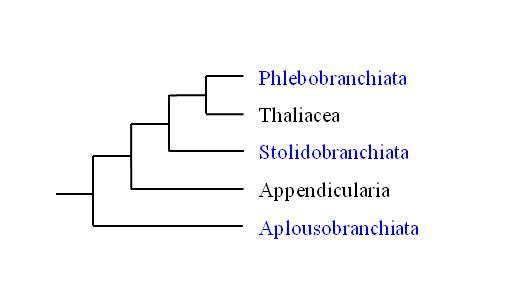Evolution & Systematics
Ascidians belong to the subphylum Tunicata (Urochordata) within the phylum Chordata. Although the adult body plan of tunicates appears to be quite derived from the fundamental chordate body plan, at some point within their life history tunicates have all of the hallmark features of a chordate (see Anatomy & Physiology). Recent phylogenies however have shown that Tunicata are highly divergent from other chordate groups, suggesting they should be named as a separate phyla (Zeng & Swalla, 2005). Within the tunicates there are three classes; Ascidiacea, Thaliacea, and Appendicularia (Stach & Turbeville, 2002). Due to the vast diversity within the Tunicata, internal phylogenies of the groups are complex and uncertain (Stach & Turbeville, 2002).
Ascidacea was traditionally considered a monophyletic group with the two planktonic tunicate classes Thaliacea and Appendicularia sister to this group. Molecular phylogenies however have placed Thaliacae and Appendicularia within the Ascidacea (Figure 1; Stach & Turbeville, 2002).

Figure 1. Phylogeny of Tunicata Classes based on 18S rDNA sequences, adapted from Stach and Turbeville (2002)
Ascidiacea suborders Stolidobranchia and Phlebobranchia contain both solitary and colonial species, as does the class Thaliacea. Appendicularia however are all solitary and Aplousobranchia are all colonial despite being placed as sister taxa by Stach and Turbeville (2002; Zeng & Swalla, 2005). It is unclear whether the ancestral tunicate was solitary or colonial. Coloniality in Stolidobranchia is distinct from that in aplousobranchs and phlebobranchs and appears to have evolved multiple times within this clade from the solitary form (Pérez-Portela et al., 2009).
The species of ascidia studied here belongs to the genus Pyura. The genus Pyura belongs to the family Pyuridae, one of three family within the suborder Stolidobranchia; Molgulidae, Stylelidae, and Pyuridae (Pérez-Portela et al., 2009). Molgulidae is widely accepted as sister to Styelidae + Pyuridae. Styelidae is paraphyletic with Pyuridae sister to one of the clades of Styelidae (Figure 2; Pérez-Portela et al., 2009). The genus Pyura is polyphyletic within the family Pyuridae (Figure 2; Pérez-Portela et al., 2009).

Figure 2. Phylogeny of Pyuridae Genera based on 18S rDNA and COI sequences, adapted from Pérez-Portela et al. (2009) |